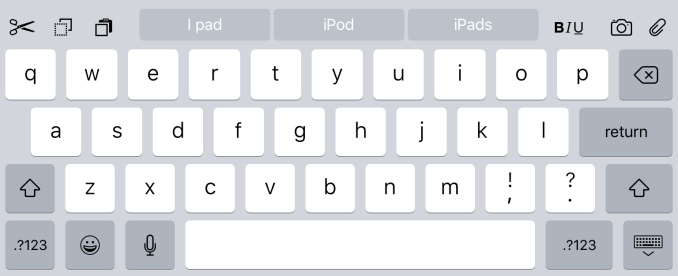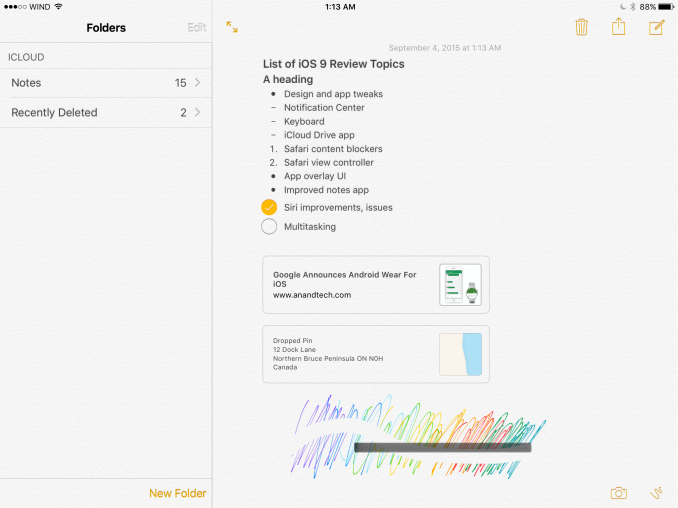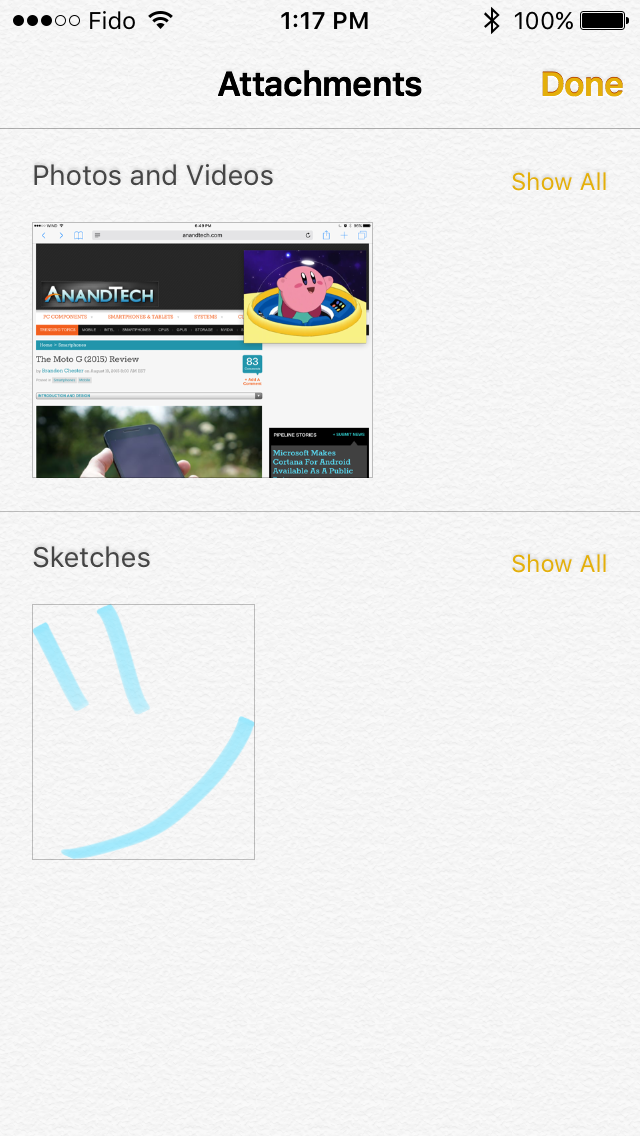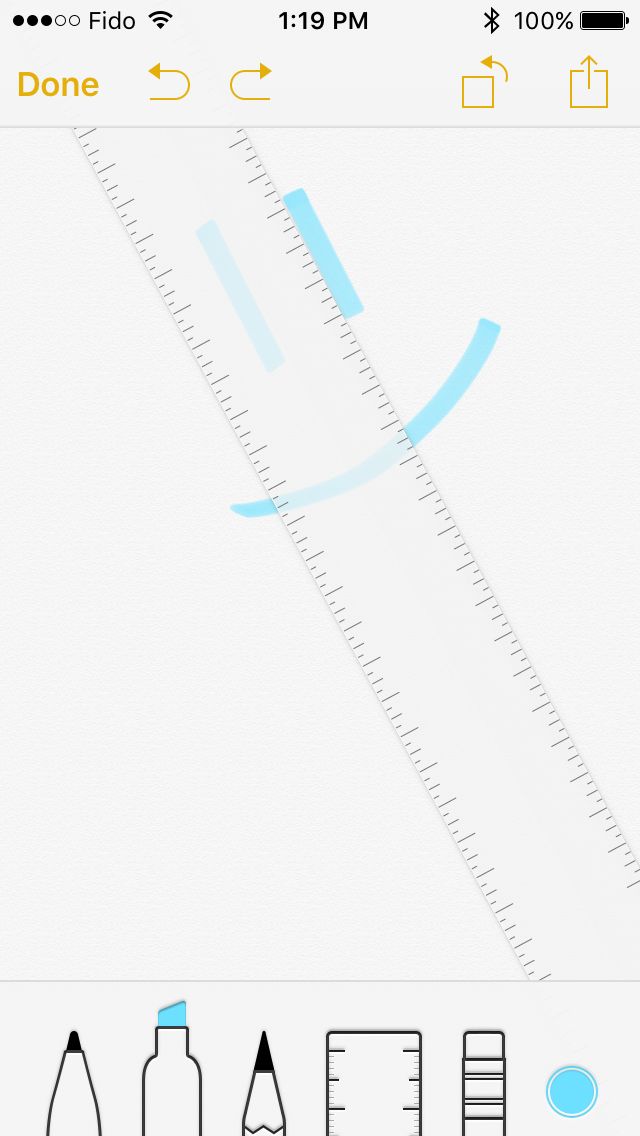The Apple iOS 9 Review
by Brandon Chester on September 16, 2015 8:00 AM EST- Posted in
- Smartphones
- Apple
- Mobile
- Tablets
- iOS 9
Low Power Mode
Low power mode is a new feature in iOS 9, and it's fairly self-explanatory. Android OEMs have been adding similar features for a while now. When your battery hits 20% the normal low battery popup will appear, but it now has a button to turn on low power mode. Apple hasn't specifically detailed what they're doing in low power mode, but they have given a broad overview of what they're doing, and some of the things can be measured manually. Low power mode makes the following changes:
- Brightness is dimmed
- Mail fetch is disabled
- Push notifications are disabled
- Background refresh is disabled
- Background network access is limited
- CPU performance is reduced
- Parallax on the home screen is disabled
- Animated wallpapers go static
With all of these changes, Apple says that low power mode can extend battery life by up to three hours if used for an entire cycle. You can actually enable the mode manually if you want by going to the battery section of the settings application. The low power mode will also automatically disable itself once the device is charged to 80%.
As for some of the specifics, I can confirm that the iPhone 5s will bring the SoC to a state where the max clock is 800MHz, while the display on this specific unit drops from 523nits to 414nits. I hope to get figures for the iPhone 6 and 6s as soon as possible, and I'll update this section once I have them. It's difficult to measure the impact of something like low power mode, as it's still heavily dependent on how you use the device. Regardless, it's good to see Apple bring this sort of feature to iOS, and I would be interested to see which users decide to use it all the time to improve their battery life even if it requires sacrificing apps running in the background and a degree of performance.
An Improved Notes Application
The iOS Notes application has been fairly simplistic since its original incarnation. You can add text, and if you long press you can insert images. Through some copy and paste magic you could end up getting text formatted with different fonts and sometimes features like bullets, but that implies that you had to write it out in another application anyway unless you’re pasting right from the web. In contrast, an application like Google Keep on Android has support for other features, like making checklists of items. Something like Evernote provides even more features that make the iOS stock app look bare in comparison. In iOS 9 the notes application receives a large overhaul, with a number of visual tweaks and new features.
Notes on iOS now supports rich text formatting. You can change whether your text is meant to be for a title, a heading, or a body of text. You can also make text bold, italicize it, or underline it. There’s still no support for fine adjustments like setting a precise text size, and for those controls you’ll still need to rely on a third party application or on Pages. To be fair, it’s not in Apple’s best interest to kill the viability of making third party note applications.
In addition to the font formatting you can also make lists using bullets, dashes, or numbers. There’s also the ability to create checklists, which I have used a few times during the course of writing this review to make sure I haven’t forgotten anything that I want to cover. You’ll also notice in the screenshot above that you can link to locations, webpages, voice recordings, and other content and they’ll be embedded in the note inside a rounded rectangle.
Something else Apple has added is the ability to draw on notes. Clicking on the squiggly line on the bottom navigation bar opens up a drawing section which has different virtual tools to draw with. There's your standard fine marker, a thicker tool like a highlighter, and a pencil. There's also a ruler which can be used to draw straight lines, and both an eraser and undo/redo buttons for any mistakes.
While the ability to draw on pages is interesting, it’s not implemented the way I had hoped it would be. Your sketches are essentially images in the note, rather than being drawings that you can position anywhere. An app like Notability lets you put scribbles wherever you wish, which can be helpful when you want to emphasize something or put yourself a note in a margin. Since your sketches are just images they have to be positioned above or below a line of text, and cannot be put to the right.
The last thing worth mentioning about the new Notes app is that Apple has also added the ability to view all the images, sketches, and attachments that exist within all of your notes. This can be helpful when trying to find a note based on a photo or a link inside it when you aren’t sure exactly what sentence or list you had in the note alongside it.
A Better iPad Keyboard
I've always felt that the iPad has one of the best first party tablet keyboards out there. I think part of it has to do with the 4:3 aspect ratio allowing for keys of greater height in landscape, which means you aren't dealing with rectangular keys that result in uneven movement depending on whether you're moving your fingers vertically or horizontally. The iPad keyboard has also had some unique features that the iPhone doesn't, such as the ability to split it into two parts by pulling outward from the middle. However, when Apple added QuickType suggestions I always felt like there was a lot of wasted space on the left and right sides where there were no suggested words. In iOS 9 the iPad keyboard gets a few feature additions that can greatly improve productivity, and fills in those empty areas in the QuickType bar while doing so.

The most obvious addition to the keyboard are the new shortcut keys on the left side of the QuickType suggestions. Depending on the context these buttons will differ, but by default you get a pair of undo and redo keys, and a paste key. If you select text these buttons change to a cut key, a copy key, and a paste key. They also change in different apps, with the Notes application condensing the standard 3 shortcuts into an overflow menu, and adding a button to create a checklist as well as a button to adjust the formatting of text.
On the right side of the keyboard are additional shortcuts that depend on the application you're in. In Notes they are buttons to insert images and access the sketch screen, while in Mail they're for text formatting, adding images, and adding attachments. Many apps don't have shortcuts here at all, and you'll have to open up the keyboard in an app to see what you get.
More interesting than the new shortcuts is the ability to use the keyboard as a trackpad of sorts. It's not something that allows you to bring up a mouse cursor and move it around the screen, but in apps where you're inputting text it allows you to move that input cursor and to increase or decrease the size of a text selection field. To use this trackpad mode you need to place two fingers on the keyboard at the same time until the keys go blank. After that you can move your fingers around and the cursor will track with them. It's a useful way to move the cursor within a sentence to insert a word, or to accurately change the size of a selection by only a letter or two.
One last thing I'd like to mention is that the case of the letters on the keyboard now changes depending on the status of the shift key. This fixes a longstanding issue with the shift key on the iOS keyboard that has existed since iOS 7. The change applies to both the iPad and iPhone keyboards, but I felt it was best to just mention it here.
Ultimately, I think the changes Apple is making to the iPad keyboard go hand in hand with the new multitasking features that I'll be discussing later in the review. They represent the iPad finally growing up and becoming its own device. It was never correct to say that the iPad was just a big iPhone, but from a high level the two devices did provide similar experiences as they used the same applications and operating system. Adding features that are very specific to the iPad differentiates it more from something like the iPhone 6 Plus, and improves its ability to be used to get actual work done.













227 Comments
View All Comments
nafhan - Wednesday, September 16, 2015 - link
Wrong. iPads get used by professionals (in addition to "prosumers") all the time for content creation tasks while on the go like music recording, viewing tablature, reviewing photos with clients, etc. Just because the content creation isn't happening on the tablet doesn't mean it's not getting used as part of a content creation workflow.That said: they are not a professionals primary content creation device. They're a secondary device that gets used when it's not reasonable to use the primary device for some reason.
The Surface is going to fall into the same boat. Someone who does these types of content creation tasks is probably going to want something more powerful than Surface for their regular work. The iPad Pro and the Surface will both be used when the primary device is not available.
Also, you are absolutely correct in that the vast majority of iPads (and computers) sold are as consumption devices. That's why the iPad mini exists!
superflex - Wednesday, September 16, 2015 - link
Yikes.A koolaid fight has broken out and everyone is drunk on their brand of OS punch.
You clowns are worse the the GPU fanbois.
Makes reading the comments at AT a waste of time.
Now get back to your respective OS shrines.
lilmoe - Wednesday, September 16, 2015 - link
You're contradicting yourself;"Just because the content creation isn't happening on the tablet doesn't mean it's not getting used as part of a content creation workflow".
That was exactly my point, and the point you emphasized in your last paragraph. iPads (even the lateset "Pro") can never be used for standalone, real professional work. The iPad "Pro" might be good for simple sketching at best... I mean, the new "pencil" doesn't even support hover or palm rejection, nor does the "Pro" run any full blown professional programs.
There's nothing an iPad can do that a Surface can't (provided the mobile app is there). But the Surface can also replace laptops for many consumers, they can be the sole PCs of many prosumers, and they can be the mobile workstations of professionals because they can run the full blown programs their used to. Something iPads can never do.
Android was never a real threat to iPads. However, while Apple isn't worried about the Surface series in particular, the real threat to iPads lies in Windows 10 and Universal Windows Platform.
I can't wait for a Samsung made Wacom Windows 10 tablet with a Core M7.
nafhan - Wednesday, September 16, 2015 - link
I'm not contradicting myself.Your argument seems to be that since it could be used as an all around replacement for every computer, professionals are using the Surface that way. My observation is that you are wrong. People who make money doing creative work generally don't have an MS based workflow, at all, and that even if they did, they'd probably still only use the Surface as a primary computer when absolutely necessary. If you're making money at your job and doing creative work, you're going to want a more powerful computer with more storage than the Surface as your main computer.
I have a feeling that you have never worked with any professionals. They don't want Swiss Army knives. They want dedicated tools to get their work done easily and quickly. I'll sort of take that back: they do want the Swiss Army knife device, just as a secondary or tertiary device, not as a primary.
The-J-Man - Friday, September 18, 2015 - link
This is changing. Some creatives are moving to Windows-based workflows as there are shifts in the industry, and Surface Pro is significant part of that. Ever since the first Surface Pro came out, the question among creatives is "Can it run Photoshop?" (Yes, it can.) Since that day, I think most creatives realize that iPads are consumption only. If you can have a tablet that is a presentation device that also lets you do actual work on a train or at a coffee shop between meetings, then isn't that better, even if it doesn't have iMessage?Apple has had some missteps lately in the creative world. The garbage can look-alike Mac Pro is selling so poorly that I don't know anyone who owns one. Adobe's Premiere Pro takeover of Final Cut market share is significant and seems to be accelerating. It is getting harder and harder to justify the IT costs of supporting a department of Macs in an otherwise Windows environment, just to get the graphics work done. (Yes, Macs need support. They are not magic.) Most artists are getting used to using Windows through Boot Camp, and Windows 10 is actually a really nice experience.
You are right that it is fairly safe to assume a creative is working on a Mac these days, but devices like Surface Pro are very impressive, even to us creatives. iPad Pro, to me, looks like a Surface Pro without the ability to run any of the apps that I really want to run. Let's face it, Creative Cloud programs like Photoshop and After Effects are where the money is, not those silly ideation apps Adobe keeps trying to push.
Most creatives work on a workstation with a Wacom tablet and multiple monitors for maximum productivity. Given the creative's standard equipment of a primary workstation, a secondary tablet/laptop, and a smartphone, I am guessing a lot of creatives would choose Surface Pro over iPad (Pro or otherwise) as their secondary device.
robinthakur - Thursday, October 1, 2015 - link
Most proper creatives doing it as a job that I know still use Apple, mainly for historic reasons it has to be said (try getting creatives to change tooling!) and the fact that the Surface Pro 3 runs Photoshop avoids the question of how well it runs it. The pen accuracy and pressure sensitivity as well as the display scaling are significant issues which hobble the SP3 to some extent and mean that it can't be used as a dedicated tool. The pen is designed primarily for OneNote, after all.The great unknown is the software for the iPad Pro. If Appl ecan persuade Adobe to release versions of CC and Micrososft to release versions of Office which are compiled for it with pen compatibility, then I can see it doing very well as all the User interface problems of not having a precision input device or keyboard will be solved.
KoolAidMan1 - Wednesday, September 16, 2015 - link
A Macbook Pro is a much better laptop than the Surface and an iPad is a much better tablet. The value of the Surface is that it combines both. If you want to combine both devices while introducing compromises then its a good option. There's certainly something to be said for having fewer things.Sc0rp - Wednesday, September 30, 2015 - link
The pencil supports palm protection dude.Morawka - Wednesday, September 16, 2015 - link
they'll lose imessage and facetime.. they dont care about safari, and everyone can agree that itunes is garbage. you seriously cited itunes as a reason to stay apple? Simplistic device are great and all, but it severely limits how you can improve them 5-10 years down the road without inherently making them more complex (therefore losing the simplicity)they are made of metal and are nice looking. the ui looks like a candy shop. they are successful because the iphone is successful. you think it will stay this way for much longer tho? It remains to be seen, but odds are not in their favor.
apple is pushing everyone to apps, even website developers (by ad blocking). apple is a compartmentalized experience on each device. They created lots of devices that only do a few things (but do them well) and then hope you buy all of them so they make lots of money.
meanwhile competitors with complex systems which allow you to do much more with fewer devices, but has steeper learning curve. do you want to pack 3-4 devices that each do a couple of things good, or 1-2 devices that can do everything.
let the market decide over the next 10 years, but eventually people will wise up and spend less money and pack less gadgets
centhar - Thursday, September 17, 2015 - link
Apple users are the Pakleds of the computer world. "We can make it go, no intelligence is required"